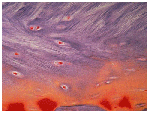Histology look-a-like #27
Fibrocartilage from an intervertebral disc (IVD) v A Mars Sky
The purple sky ‘trails’ are Type I collagen fibers within the annulus fibrosus. These resist the tensile forces applied to a disc during movement of the vertebral column.
The red ‘comets’ are chondrocytes. Mature cartilage cells trapped within lacunae.
The orange-red material at the lower aspect of the image is the core of the IVD – termed the nucleus pulposus.This forms a gel that is composed of the proteoglycan aggrecan. Aggrecan is hydrophilic and draws water into this region of the IVD. Water is difficult to compress, therefore this central region is specialized for resisiting compressive forces applied to the vertebral column.
You can see that the histological organization of fibers and aggrecan molecules in the IVD allows it to function in resisting both the tensile and compressive forces applied to the vertebral column every single day.
Simply A-mars-ing,
i-heart-histo x
Sources:
IVD micrograph: Moran and Rowley via Flickr
Mars: Viking Orbiter Images, NASA) shows Crater Schiaparelli
Gif and bad puns by i-heart-histo

